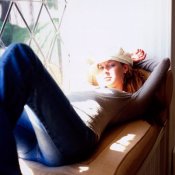"Expose for the highlights" holds true for reversal film. Patchy areas of solid black in an image, where shadows have no detail, are more acceptable than bleached (or 'blown') highlights. If an image has vast areas of deep, featureless black, the lighting has not been read correctly. Diffuse light (overcast, hazy) favours Velvia. Point light (clear sunny sky with deep shadows) is not a design intention of Velvia: it looks just awful in bright light, though some landscape photographers do exploit this. Spectral highlights can be managed using a polariser, taking care to increase the exposure if you flatten spectrals across the scene, otherwise the result will look very dull and flat, even if primaries are enhanced (with Velvia, that's the greens, especially, then reds).
If your camera has a spot meter, meter from a highlight (this will be the brightest part of the scene where you want to record detail) then a shadow (as a reference)between these no more than 2.3 stops) and mid-tone (the proverbial 18% grey or Zone V, i.e. grey stone, granite, wood, a lot of light autumnal foliage...), then average all three these readings. This is a good start. You can of course take multiple readings. Cameras that have an exposure scale make this averaging more meaningful (to a point) by moving locked readings for hi/lo/mid-tone up or down until the averaged reading sits within a comfortable exposure range. It won't however always appear 'just so' like this, which is where you must apply judgement. Diffuse light will return the best results with Velvia and Kodak reversal stock. There are ways you can get smart: a hand-held meter in incident mode can be used (remember to include filter factor and ISO speed as per what you have on the camera). While useful, incident readings only measures illumination over the scene, while spot metering takes into account individual luminances on various elements in the subject; this is thorough, but also time consuming, requiring an understanding of applying Zone System principles (in contracted form i.e. 5 stops and not 11). Tranny film is wonderfully rewarding to view on the light table when you work within its limitations.
I concur that matrix and evaluative metering systems do an excellent job in the right circumstances, but they don't know that the film you have loaded in the camera has a narrow latitude and they don't care, so don't put all your eggs in the one basket, but do be prepared to take control away from the camera's assertions for learning purposes.





